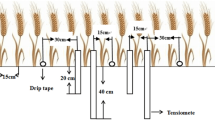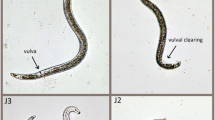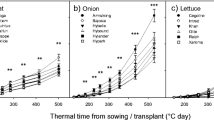Summary
A method is described for rapidly estimating the depth of penetration and density of roots of cereal crops under field conditions. Counts of living roots, traversing horizontal faces of soil cores, were made for winter wheat growing on direct-drilled and ploughed land.
The rate of penetration of roots of winter wheat in a clay and a sandy loam soil averaged 5 mm per day throughout winters without extremes of cold or wet. Death of roots near the soil surface occurred wilst others continued downward penetration. The rate of root elongation was slower during prolonged periods when the soil was wet and faster,i.e. to greater depths, during dry conditions.
Damage sustained to roots during adverse winter conditions ofter varied between direct drilling and ploughing. More roots at depth were consistently recorded on direct-drilled than on ploughed land when measured in spring after a soil water deficit had developed during the preceding month. After prolonged wet soil conditions during the winter on a soil with a large clay fraction and low hydraulic conductivity, root growth and penetration in spring, before the development of a soil water deficit, was more restricted on direct-drilled than on ploughed land.
Similar content being viewed by others
References
Abdalla, A. M., Hettiaratchi, D. R. P. and Reece, A. R. 1969 Mechanics of root growth in a granular media. J. Agric. Eng. Res.14, 236–248.
Avery, B. W. 1973 Soil classification in the Soil Survey of England and Wales. J. Soil Sci.24, 324–338.
Bakermans, W. A. P. and de Wit, C. T. 1970 Crop husbandry on naturally compacted soils. Neth. J. Agric. Sci.18, 225–246.
Barnes, B. T. and Ellis, F. B. 1979 The effects of different methods of cultivation and direct drilling, and disposal of straw residues, on populations of earthworms. J. Soil Sci.30, 669–679.
Burford, J. R., Dowdell, R. J. and Crees, Rachel. 1978 Denitrification: Effect of cultivation on fluxes of nitrous oxide from the soil surface. Report Agricultural Research Council Letcombe Laboratory 1977, 71–72.
Cannell, R. Q., Davies, D. B., Mackney, D. and Pidgeon, J. D. 1978 The suitability of soils for sequential direct drilling of combine-harvested crops in Britain. Outl. Agric.9, 306–316.
Cannell, R. Q., Ellis, F. B., Christian, D. G., Graham, J. P. and Douglas, J. T. 1980 The growth and yield of winter cereals after direct drilling, shallow cultivation and ploughing on non-calcareous clay soils, 1974–78. J. Agric. Sci. Camb.In press.
Cannell, R. Q. and Graham, J. P. 1979 Effects of direct drilling and shallow cultivation on the nutrient content of shoots of winter wheat and spring barley on clay soils during an unusually dry season. J. Sci. Food Agric.30, 267–274.
Drew, M. C. and Saker, L. R. 1978 Effects of direct drilling and ploughing on root distribution in spring barley, and on the concentrations of extractable phosphate and potassium in the upper horizons of a clay soil. J. Sci. Food Agric.29, 201–206.
Drew, M. C. and Saker, L. R. 1980 Assessment of a rapid method, using soil cores, for estimating the amount and distribution of crop roots in the field. Plant and Soil55, 297–305.
Douglas, J. T. 1977 Personal communication.
Dowdell, R. J., Crees, R., Burford, J. R. and Cannell, R. Q. 1979 Oxygen concentrations in a clay soil after ploughing or direct drilling. J. Soil Sci.30, 239–295.
Ellis, F. B. and Barnes, B. T. 1971 A mechanical method for obtaining soil cores. Plant and Soil35, 209–212.
Ellis, F. B., Elliott, J. G., Barnes, B. T. and Howse, K. R. 1977 Comparison of direct drilling, reduced cultivation and ploughing on the growth of cereals. 2. Spring barley on a sandy loam soil; soil physical conditions and root growth. J. Agric. Sci. Camb.89, 631–642.
Ellis, F. B., Elliott, J. G., Pollard, F., Cannell, R. Q. and Barnes, B. T. 1979 Comparison of direct drilling, reduced cultivation and ploughing on the growth of cereals. 3. Winter wheat and spring barley on a calcareous clay. J. Agric. Sci. Camb.93, 391–401.
Ellis, F. B. and Lynch, J. M. 1977 Why burn straw? Agricultural Research Council Research review3, 29–33.
Finney, J. R. and Knight, B. A. G. 1973 The effect of soil physical conditions produced by various cultivation systems on the root development of winter wheat. J. Agric. Sci. Camb.80, 435–442.
Garwood, E. A. and Williams, T. E. 1966 Soil water use and growth of a grass sward. J. Agric. Sci. Camb.68, 281–292.
Goss, M. J. 1977 Effects of mechanical impedance on root growth in barley (Hordeum vulgare L.). J. Exp. Bot.28, 96–111.
Goss, M. J., Howse, K. R. and Harris, W. 1978 Effects of cultivation on soil water retention and water use by cereals in clay soils. J. Soil Sci.29, 475–488.
Gregory, P. J., McGowan, M., Biscoe, P. V. and Hunter, B. 1978 Water relations of winter wheat. I. Growth of the root system. J. Agric. Sci. Camb.91, 91–102.
Hellreigel, H. 1883 Beiträge zu den naturwissen-schaftlichen Grundlag des Ackerbaus mit besonderer Berücksichtigung der agrikultur-chemischen Methode der Sandkultur. Braunschwig: F. Vieweg u Sohn, 118–280.
Hodgson, D. R., Proud, J. R. and Browne, S. 1977 Cultivation systems for spring barley with special reference to direct drilling. J. Agric. Sci. Camb.88, 631–644.
Jarvis, M. G. 1973 Soils of the Wantage and Abingdon District. Memoirs of the Soil Survey of Great Britain. 72–75.
Melhuish, F. M. and Lang, A. R. G. 1968 Quantitative studies of roots in soil. I. Length and diameter of cotton roots in clay loam soil by analysis of surface-ground resin impregnated soil. Soil Sci.106, 6–22.
Pidgeon, J. D. and Soane, B. D. 1977 Effects of tillage and direct drilling on soil properties during the growing season in a long-term barley monoculture system. J. Agric. Sci. Camb.88, 431–442.
Russell, R. S. 1977 Plant Root Systems: Their Function and Interaction with the Soil. London. McGraw-Hill, 298 p.
Schuurman, J. J. and Knot, L. 1957 The estimation of amounts of roots in samples bound for root investigations. (Dutch, Engl. Sum.). Versl. Landbouwkd. Onderz.63, 14.
Troughton, A. 1962 The roots of temperate cereals (wheat, barley, oats and rye). Commonwealth Bureau of pasture and Field Crops. Mimeographed Publ.21.
Welbank, P. J., Gibb, M. J., Taylor, P. J. and Williams, E. D. 1973 Root growth of cereal crops. Rep. Roth. Exp. Stn. Part2, 22–66.
Welbank, P. J. and Williams, E. D. 1968 Root growth of a barley crop estimated by sampling with powered soil-coring equipment. J. Appl. Ecol.5, 477–481.
Author information
Authors and Affiliations
Rights and permissions
About this article
Cite this article
Ellis, F.B., Barnes, B.T. Growth and development of root systems of winter cereals grown after different tillage methods including direct drilling. Plant Soil 55, 283–295 (1980). https://doi.org/10.1007/BF02181808
Received:
Revised:
Issue Date:
DOI: https://doi.org/10.1007/BF02181808




